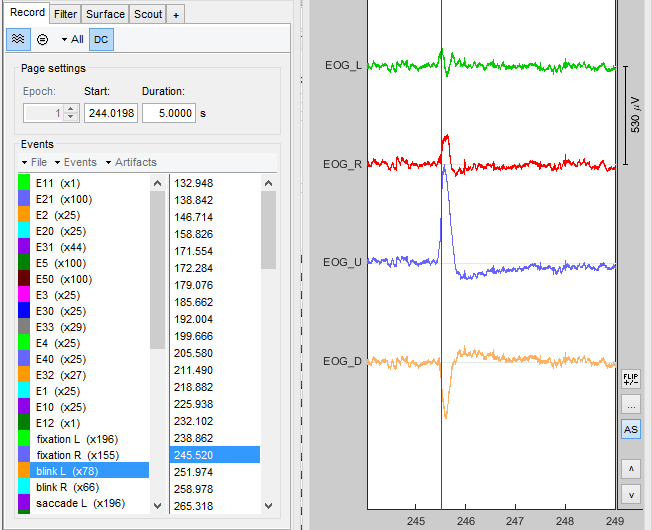|
Size: 3667
Comment:
|
Size: 4247
Comment:
|
| Deletions are marked like this. | Additions are marked like this. |
| Line 28: | Line 28: |
| Line 30: | Line 31: |
| Line 38: | Line 40: |
| Line 53: | Line 56: |
| . {{attachment:evttransferTut_p2.png||height="324",width="389"}} . |
{{attachment:evttransferTut_p2.png||height="324",width="389"}} . |
| Line 62: | Line 66: |
| . {{attachment:evttransferTut_p3.png||height="155",width="581"}} |
|
| Line 63: | Line 69: |
== Verification == It is important to check if the event transfer was executed properly. For that, there are multiple possibilities: * If your recordings contain EOG channels, you can e.g. check if the blinks are marked correctly {{attachment:evttransferTut_p4.png||height="530",width="652"}} <<BR>> * If the two data sets share another event (besides the sync event you specified before), you can check if those are always marked at the same times * Control if the number of events in each file meets your expectations |
|
| Line 66: | Line 83: |
| == Process options == ... |
Tutorial XX: Synchronization with Eyetracker data (event transfer)
Authors: Francois Tadel, Martin Völker
This tutorial introduces how to transfer events from one data set to a second data set of a different type, which was recorded at the same time.
We will explain this on the example of synchronizing ocular data recorded with an EyeLink eye tracker (SR Research, Canada) with a second raw recording, e.g. EEG.
Introduction
Eye tracking is useful to detect blinks, saccades, microsaccades and fixations during an experiment. Typically, the eye tracker software will itself mark the most common artifact types like blinks and saccades.
These artifact markers are very useful for the analysis of EEG / MEG data, since specific time periods which are contominated with artifacts can be marked and excluded easily. To do so, we need to synchronize the eye tracker data with our EEG / MEG recordings.
This tutorial focusses on how to snychronize EyeLink data (.edf) within brainstorm with raw data within brainstorm.
Information about the EyeLink can be found at http://www.sr-research.com/index.html.
Requirements
For this function to work, you need specific markers, which are stored within both EEG/MEG and eye tracker data at the same time. The exactly same number of this marker type has to be available in both data sets. They can, however, have different names.
Data import
First of all, the raw recording has to be linked to your brainstorm database, if not already done (?Review continuous recordings).
The EyeLink .edf file can be linked the same as the EEG recordings:
Switch to the "functional data" view.
Right-click on the subject folder > Review raw file
Select the file format: "EyeLink eye tracker (*.edf)"
- Select the .edf file(s)
- Click "open"
- Due to the file format, the loading can take a while
Event transfer
Now click on the "Process2" tab.
Into "Files A", drag and drop the raw data files from which you want to copy the events (in this case, the EyeLink files)
- Into "Files B", drag and drop the recordings into which you want to paste the events; in our case, the EEG recordings.
It does not matter if the number of files in A and B is different. However, the number of sync markers within each data set has to match.
Now click on
- RUN
- Process selection: Synchronize
- Transfer events ( from A to B )

In this example, the synchronization event is called "5" within the EyeLink data set and "E5" within the EEG data set.
After clicking "Run", the function will try to calculate the offsets between the data sets with the help of the Sync events, which are known to be occuring at the exact same time.
Within Matlab, the variance of the sample offset (and the standard deviation) is displayed per file of the destination data set.
If the variance is too high, something is wrong with the Sync events. For example, when the files in "B" are in the wrong order, the offsets will differ a lot and thus have a high variance. Depending on the timing of your recording and marker system, small variations are however perfectly normal.
Verification
It is important to check if the event transfer was executed properly. For that, there are multiple possibilities:
- If your recordings contain EOG channels, you can e.g. check if the blinks are marked correctly

- If the two data sets share another event (besides the sync event you specified before), you can check if those are always marked at the same times
- Control if the number of events in each file meets your expectations
Additional documentation
Forum: Development of eye tracker support http://neuroimage.usc.edu/forums/showthread.php?2193-Is-eye-tracker-data-support-interesting-to-Brainstorm


